
HealthHack 2014: The Story of a Bar Chart
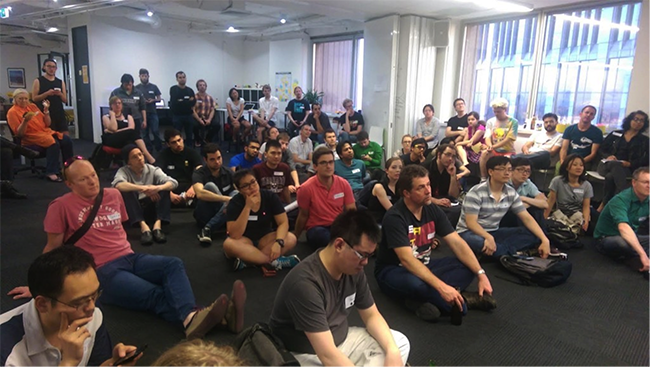
“I’ve got this other idea, but I’m not sure if it’s really appropriate. It’s probably really boring. I want to show who gets National Health and Medical Research Council grants and who doesn’t. The NHMRC release all this data but it’s in spreadsheets and PDFs. I spent so many months last year pulling the data together. It looks like an upside down wine glass! Early- to mid-career scientists are mostly women, and the further you go up the chain, the more money gets given to men who should have retired but are still hanging around for 15 years.”
Meet Marguerite (Maggie) Evans-Galea. Maggie founded the Australian Academy of Science Early to Mid Career Researchers Forum. It gathers information about challenges of younger researchers and lobbies government for science policy reforms.
It’s a thing ‘everybody knows’ in life sciences: the start of the pipeline is full of women. ‘Everybody knows’ the people who get grants are senior male researchers. It’s a lot easier to explain with pictures.
Big data it isn’t – the input was just 1000 excel rows. But now, Maggie can show the too-many-old-men problem to man-in-charge-of-not-landing-the-government-on-front-page-of-The-Australian, in a format he can understand: the humble bar chart.
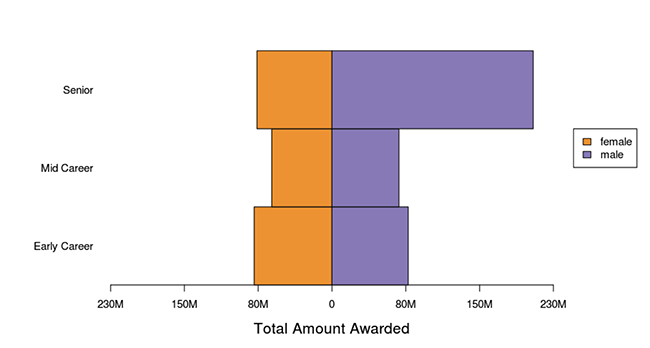
[Amount of NHMRC funding awarded in 2013 broken down by sex and career stage.]
They’ve got heat maps too, but they’re not as telling for a minister’s adviser.
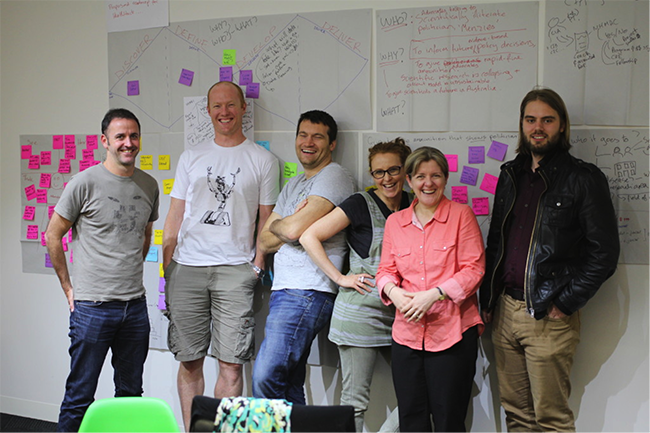
[Aaron McAleese, Sean Fleming, Iulian Stefanica, Irith Williams, Marguerite Evans-Galea and Scott Ritchie, winning team of HealthHack Melbourne 2014.]
Maggie’s project idea won HealthHack in Melbourne. She is now in all kinds of interesting conversations with government departments that shall remain nameless.
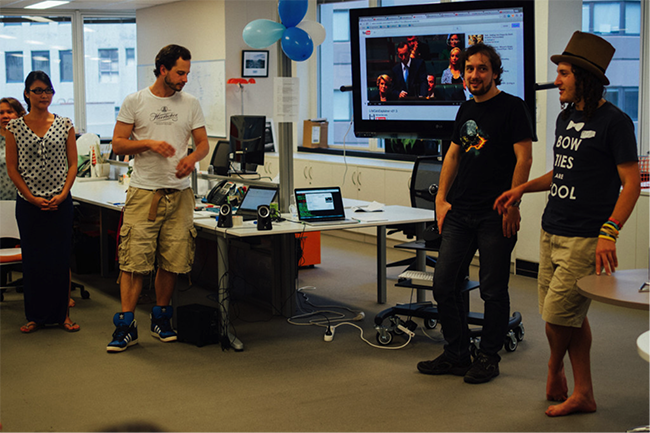
The Sydney first prize winner is delighted. They extended an existing open source project to create a family pedigree drawing tool. The current tools for clinical geneticists include one that lets the user draw a family tree, and a different one that provides a list of family members and their genetic variants. It’s so frustrating for geneticists they usually end up drawing family trees on paper. The tool Andreas Zankel’s group created does both, and then some.
“We’ll be using this on Monday!”
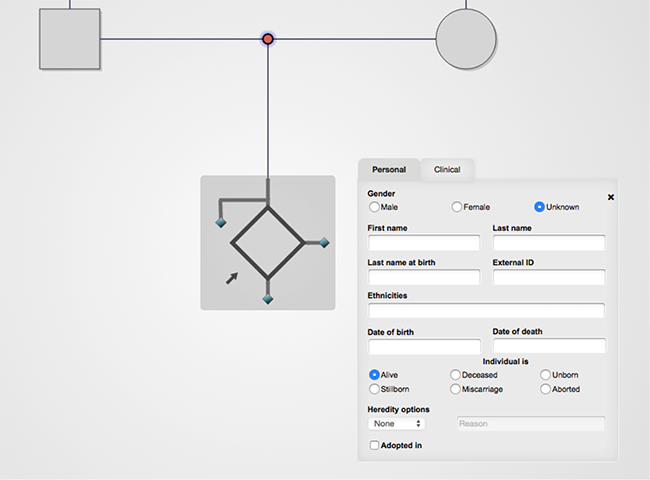
[Phenotips extension family pedigree tool]
Then there’s Clare Coleman, the Sydney researcher who learned to JavaScript over the weekend. Her team didn’t start writing code until late Saturday, by then they had a clear picture of what their Minimum Viable Product would be. Clare offered to work on the function that would do most of the calculations.
“What language do I use? I only know Pascal. Well, Delphi.” Two hours later Clare came back and said “I’m done, I think”.
After changing a few commas to semicolons and writing a unit test, the function was added to the website.
Their group didn’t win a prize, but they did make a nice tool for showing how various parameters affect life expectancy of Aboriginal people. You might want to watch their video.
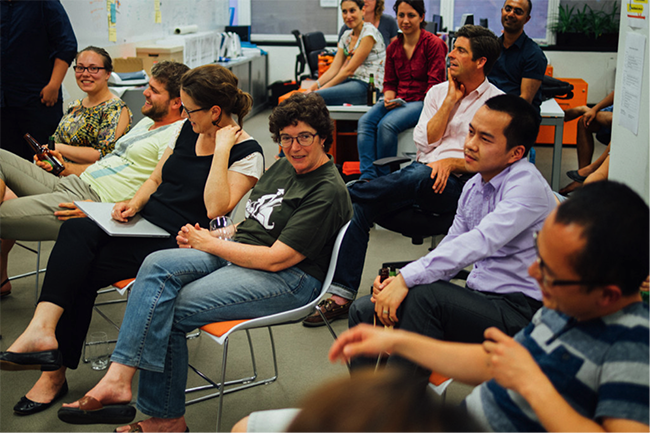
[Clare Coleman at HealthHack Sydney]
Nobody used the cluster installed especially for the weekend (thank you V3 Alliance!), but one group in Melbourne worked to optimise a processing pipeline problem on the VLSCI (Victorian Life Sciences Computation Initiative) supercomputer. You can really feel for them, all they got was a special mention (and some good options for managing an evolutionary biologist’s python workflow). Nobody’s sure if Sydney’s equivalent of the ugly duckling did in fact have better results, or were just able to articulate them better – hard to argue with “What used to take 3 days now takes 3 minutes”, but they won second prize.
Back in Melbourne, Charles Galea came in with a problem that’s been plaguing the field of biosciences for some time. Once a protein is linked to a disease, the next question becomes: which mutations are important?
A protein can have many point mutations, some can be fatal to the protein, others have little effect. Genomics can tell us where mutations occur, but establishing which are actually associated with disease is done via expensive, laborious, time consuming experimental work.
But wait! Structural biologists have the power to examine proteins and tell which mutation is most likely to have major repercussions on the protein, and therefore the human it floats in. Charles, a structural biologist, uses a selection of online tools to do that. Download sequences here, upload there, configure web app after web app. It’s tedious and it takes forever. Charles’s group created a tool that semi-automates this process and shows all results in the one place.
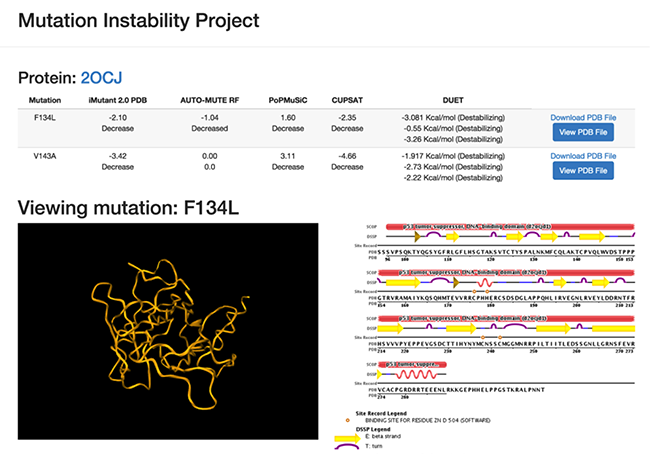
[The Mutation Instability Filter helps structural biologists to determine which point mutations in proteins are most likely to cause disease]
Charles can now do his analyses in a fraction of the time, an army of young postdocs can come into the lab on weekends knowing their efforts are effectively utilised, and the devs got to play with biology.
Know what they won? Charles Galea, scientist at the Murdoch Children’s Research Institute, won half a day shadowing scientist Maggie Evans-Galea at the Murdoch Children’s Research Institute.
(The prize went to the developers. They’re genuinely thrilled.)
There’s also the group that created two mobile apps over the weekend, for another first-of-its-kind: tracking gamblers’ addictive behaviour and mood out in the wild, realtime, not just in the psychologist’s office. It’s a survey-based ‘like fitbit for addiction’. It’s nothing revolutionary from a tech perspective, but it’s changed what the field of psychology can do. The research group Ben Fulcher And George Youssef work in have a proof of concept they can use to get more funding for employing developers.
One of their devs left early on Saturday to his job at Crown Casino. He had some choice ideas for user testing.
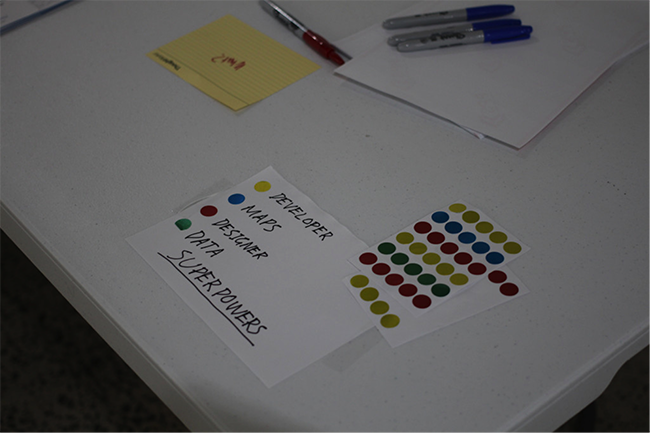
[Superpowers]
HealthHack is all about solving problems that researchers face. It’s about demonstrating to scientists the value of investing in good software and design. If they can see why they need it, they’ll pay for it.
It’s also about getting software people into science. We often hear something to the effect of “It’s so good to work on something other than finance back end integration. I had no idea this was so interesting.”
Although the main output of HealthHack was open products to assist health researchers, there was a secondary output, which is just as important: networks built across communities. The participants on many teams promised to remain in contact, and even continued discussions with researchers on how to better the tools they created over the weekend.
We have a lot of lovely emails from participants with quotes like these:
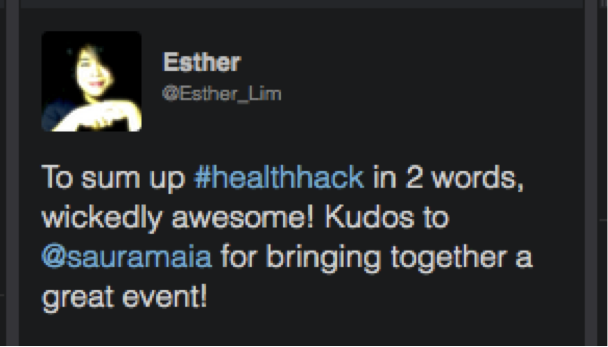
Makes it all worthwhile.
Thanks to:
- Maia Sauren, overall HealthHack supreme organiser
- Kelvin Nicholson, Sydney HealthHack puller-together, sponsor wrangler extraordinaire and Open Knowledge Hackathon repeat offender
- Website and graphics: Nic Smythe, Nigel Fernandez, Amanda Wise, Svetlana Filimonova, Carol Mak
- Logistics and management: Dan Samson-Gower, ops hero, who juggled a family holiday with two kids under 5 with panicky messages about network wrangling; Olivia Leonard, marketing; Health Informatics Society of Australia; Andrew Chalmers, cluster guardian; Rose Elhage, whirlwind
- Melbourne volunteers: Andrew Scott, Matt Cenga, Jordan Wilson-Otto, Olivia Platek, Dejan Jotanovic, Martin Feckie, Luke McDonald, Nat Young, Mayase Jere
- Sydney volunteers: Shaheedha Hussainiah, Paul Manuel Joseph, Frederic Lemay, Venus Izadi, Esther Butcher, Marzieh Morovatpasand
- Judges: Steve Bennett, Matt Ritchie, Jarni Choi, Alison Stringer, Anthony Sceresini
- Our sponsors: Thoughtworks Australia, RedHat, Walter & Eliza Hall Institute, The Garvan Institute, V3 Alliance, VLSCI, NeCTAR, Life Letters, GitHub and Fishburners HealthHack is proudly part of the ChangeMakers Festival.
Additional Links:
Disclaimer: The statements and opinions expressed in this article are those of the author(s) and do not necessarily reflect the positions of Thoughtworks.














